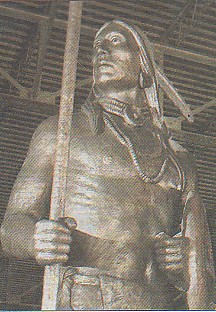 Seventeen feet above the
floor of a northwest Oklahoma City warehouse glares the face of a bronze
warrior whose job soon will be to protect the spirit and values of Oklahoma.
Seventeen feet above the
floor of a northwest Oklahoma City warehouse glares the face of a bronze
warrior whose job soon will be to protect the spirit and values of Oklahoma.
The warrior named "The Guardian," will adorn the top of the state capitol's new dome in June and will remain facing east toward the sunrise until sometime after 2100, when it will be taken down and cleaned.
On May 15, 2002, workers brushed the last of the bronze coloring onto the statue's half-inch thick skin.
The 6,000-pound statue will be hoisted to the top of the nearly finished dome June 7, wind permitting. The public can view and touch the warrior on the north side of the Capitol from June 1 until June 6.
It will be the only American Indian statue to sit atop a state capitol in the nation, and-with spear in hand-will rise more than 5 feet higher than the statue on top of the nation's capitol in Washington.
Sen. Kelly Haney, D-Seminole, who was selected in a blind contest based on entries submitted without the sculptors being identified, said the statue will face east toward the sunrise to uphold a tradition.
Haney said the warrior does not represent any particular tribe, but features common themes and traditions from several Indian Nations. He chose to sculpt a warrior from a time before Europeans arrived with clothing, jewelry and a weapon made of materials found in nature. He used his athletic 18-year-old neighbor, Derek Roper, as the model for the warrior's defined body and the features of his children to sculpt the face.
The shield in the warrior's left hand is a circle to represent the Indian belief that all things are equal in value. On the shield is a cross, symbolizing the four directions, four seasons and four cycles of life. Haney said the number four is a sacred number. For that reason, he hung four feathers from the bottom of the shield.
Around the warrior's neck are three rings of beads with a shell in the center and two longer bead necklaces draped across his chest. Haney said the beads resemble strands of fish bones he found in riverbeds as a child. He said they would string together the strands of bones and make "bead" necklaces.
The most difficult feature to see, which Haney said is one of the most important parts of the statue, is a small strap flowing from the bottom of the warrior's leggings. The strap starts at the warrior's waist, then travels down the legging to the floor, where it is stuck to the ground with the spear. Haney said that when warriors were faced with seemingly insurmountable odds, they would stake themselves to the ground by driving their spears through the strap. It was a sign, he said, of bravery and courage.
"Oklahoma is faced with all the tragedies we have...and Oklahomans have a way of standing back up and fighting for those values," Haney said.
The Guardian will be available to the public from 9a.m. to 5p.m. June 1 through June 6. The dome-topping ceremony will be June 7, 2002.
-courtesy of Diane Plumberg Clay and The Daily Oklahoman
![]()
©2002-2004 Linda Simpson
![]()
02 August, 2015